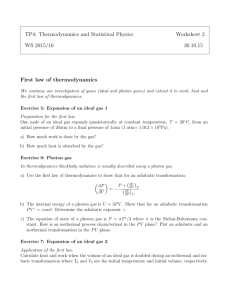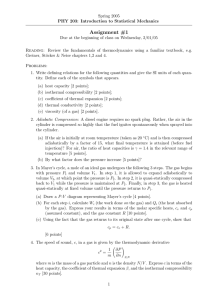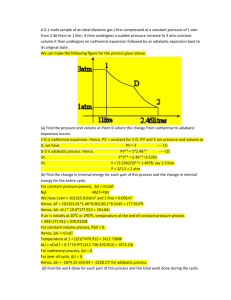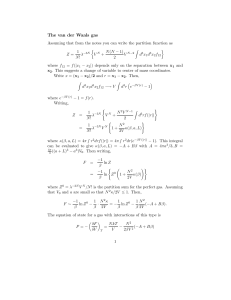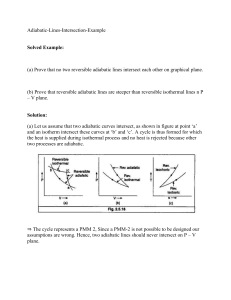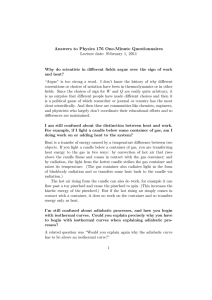Fall 2009 E. Jenkins DEPARTMENT OF PHYSICS PHYSICS 140A
advertisement
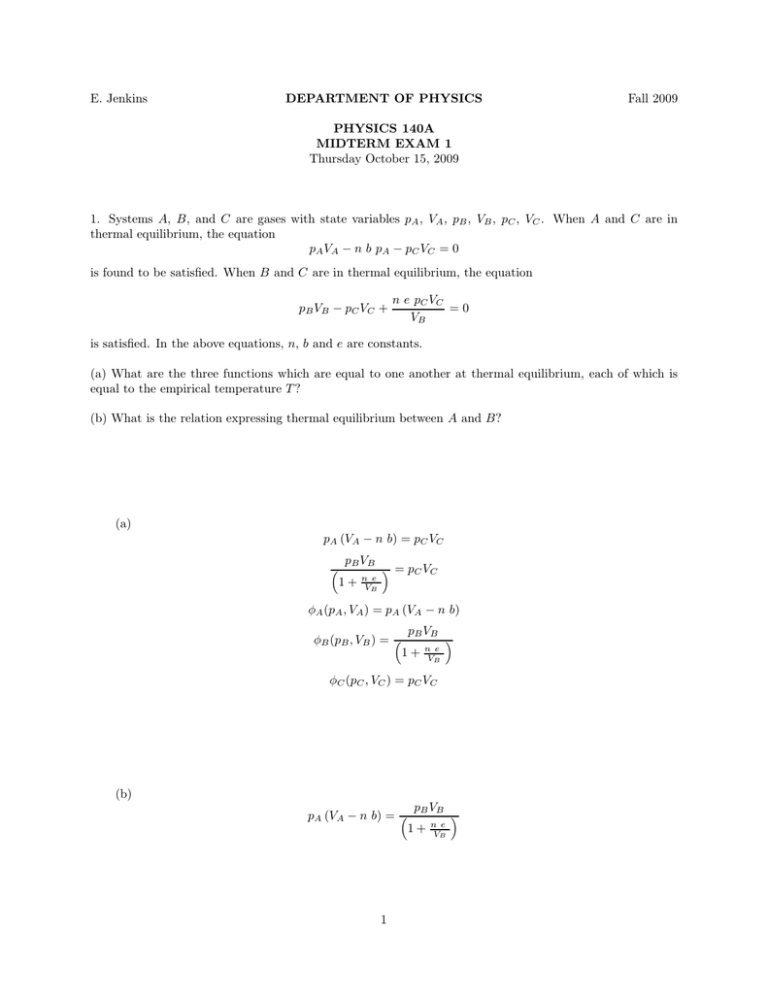
E. Jenkins DEPARTMENT OF PHYSICS Fall 2009 PHYSICS 140A MIDTERM EXAM 1 Thursday October 15, 2009 1. Systems A, B, and C are gases with state variables pA , VA , pB , VB , pC , VC . When A and C are in thermal equilibrium, the equation pA VA − n b pA − pC VC = 0 is found to be satisfied. When B and C are in thermal equilibrium, the equation pB VB − pC VC + n e pC VC =0 VB is satisfied. In the above equations, n, b and e are constants. (a) What are the three functions which are equal to one another at thermal equilibrium, each of which is equal to the empirical temperature T ? (b) What is the relation expressing thermal equilibrium between A and B? (a) pA (VA − n b) = pC VC p V B B = pC VC 1 + nVBe φA (pA , VA ) = pA (VA − n b) pB VB φB (pB , VB ) = 1 + nVBe φC (pC , VC ) = pC VC (b) pA (VA − n b) = 1 pB VB 1+ n e VB 2. The internal energy U of a photon gas is related to its volume V and temperature T by U = aT 4 , V where a is a constant. The equation of state is given by p= 1U a = T 4, 3V 3 so that the pressure depends only on temperature. (a) Calculate how the temperature of a photon gas varies with volume during a quasi-static, reversible, adiabatic compression of the gas. [You should find a result of the form T α V = constant, with a specific value for the constant α. (b) What is CV for a photon gas? (c) What is the enthalpy H for a photon gas? (a) dU = U = U (T, V ) ∂U ∂U dT + dV ∂T V ∂V T dQ ¯ = dU + p dV ∂U ∂U dT + + p dV dQ ¯ = ∂T V ∂V T 1 ∂U ∂U dT + + p dV = 4a V T 3 dT + a T 4 + a T 4 dV 0= ∂T V ∂V T 3 1 4 0 = 4a V T 3 dT + a T 4 + a T 4 dV = 4a V T 3 dT + a T 4 dV 3 3 4 0 = 4a V T 3 dT + a T 4 dV 3 dT dV 3 + =0 T V T 3 V = constant (b) U (T, V ) = a V T 4 ∂U = 4a V T 3 CV = ∂T V (c) H =U +p V = 4 4 a V T4 = U = 4 p V 3 3 2 3. During a quasi-static, reversible and adiabatic expansion of an ideal gas, the pressure at any given moment is given by pV γ = c, where γ and c are constants. (a) Show that the work done by the gas in expansion from volume VA to volume VB is pA VA − pB VB . γ−1 W (A → B) = (b) If the initial pressure and volume of the gas are pA = 106 Pa and VA = 10−3 m3 , and the final volume is VB = 3.2 × 10−2 m3 , what is the final pressure? Assume that the gas is diatomic, so γ = 57 = 1.4. How many joules of work is done by the gas in the adiabatic expansion? (c) What is the work done by one mole of the gas if the expansion is isothermal rather than adiabatic? What is the final pressure? (d) Sketch a picture of the adiabatic and isothermal expansion curves for the expansions of parts (b) and (c) in the p − V plane. (x-axis is V , y-axis is p.) Be sure to label the curves as adiabatic and isothermal. (a) W = Z VB p(V ) dV = c Z VB V −γ dV = VA VA c (1 − γ) V 1−γ |VVB A 1−γ c 1 = − VA 1−γ = VB [pB VB − pA VA ] (1 − γ) (1 − γ) (b) pA VA γ = pB VB γ γ 1 7/5 1 VA 6 = × 106 Pa = 10 Pa pB = pA VB 32 128 pA VA − pB VB 1 15 5 6 W = 1− = 10 Pa 10−3 m3 = × 103 J γ−1 2 4 8 (c) W = Z VB Z p(V ) dV = R T VA = pA VA ln VB VA VB VA dV = R T ln V VB VA = ln(32) × 103 J ≈ 3.5 × 103 J. pA VA = pB VB 1 VA = × 106 Pa pB = pA VB 32 3 4. In this problem, you consider the expansivity β and the isothermal compressibility κ. (a) Show that β and κ of a general system satisfy ∂β ∂κ + =0. ∂p T ∂T p (b) Consider a van der Waals gas with equation of state p= RT a − 2 . (v − b) v Compute β and κ for a van der Waals gas. (c) Show that ∂p ∂T = v β κ is generally true. ∂p (d) Compute ∂T from the van der Waals gas equation of state. Verify that v ∂p ∂T v = β κ is true for the van der Waals gas. (a) ∂v ∂T p 1 ∂v κ=− v ∂p T " # 2 ∂β 1 1 ∂v 1 ∂v ∂ ∂ v ∂v = − 2 = ∂p T ∂p T v ∂T p v ∂p∂T v ∂T p ∂p T 2 ∂ 1 ∂v 1 1 ∂v ∂ v ∂v ∂β ∂κ = − =− + 2 =− ∂T p ∂T p v ∂p T v ∂T ∂p v ∂p T ∂T p ∂p T β= (b) 1 v 1 a T = p + 2 (v − b) R v a 1 2ab ∂T p− 2 + 3 = ∂v p R v v 4 ∂T a 2ab 1 pv − + 2 = ∂v p R v v R 1 ∂v = β= v ∂T p pv − va + 2ab v2 v p= RT a − (v − b) v 2 RT ∂p 2a =− + 3 ∂v T (v − b)2 v RT v 2a ∂p = − 2 −v ∂v T (v − b)2 v 1 ∂v 1 (v − b) κ=− = RT v = 2a v ∂p T pv − av + 2ab (v−b)2 − v 2 v2 (v − b) T β β= R p + va2 κ= (c) f (p, v, T ) = 0 ∂T ∂v ∂p = −1 ∂T v ∂v p ∂p T ∂v 1 ∂v β ∂p 1 ∂T p v ∂T p =− ∂v = − ∂v = 1 ∂v = κ ∂T ∂T v − v ∂p ∂v p ∂p ∂p T T RT a − (v − b) v 2 T (d) ∂p ∂T v κ= = ∂ ∂T v 1 RT v (v−b)2 − 2a v2 = = R β = (v − b) κ (v − b) (v − b) β = R pv − av + 2ab v2 5




